Abstract
The rapid evolution of biotechnology across various sectors, including agriculture, industry, and medicine, has profoundly transformed our comprehension of the world. Virtual laboratories (VLs) provide an immersive learning experience that can enhance future generations’ understanding of biotechnology’s medical applications. This study investigated the impact of incorporating VLs into a short course on biotechnology applied to medicine on the attitudes and perceptions of third-year medical students (n = 210). A validated questionnaire was employed to assess their perspectives, attitudes, and experience with virtual laboratory platforms before and after the course. The findings revealed a significant positive change in 7/38 questionnaire items (p < 0.05), indicating that the VL experience modified perceptions about biotechnology. This study emphasizes the importance of exploring innovative teaching methods for biotechnology and highlights the advantages of VL in educating future physicians. The primary concerns of the students were the misuse of personal genetic information and biotechnological applications involving animal modification. Overall, the students had a favorable experience using the virtual laboratory platforms. These findings collectively suggest that VL can positively influence perceptions and attitudes toward biotechnology among healthcare professionals.
1. Introduction
The rapid development of biotechnology in different areas like agriculture, industry, and medicine plays a significant role in the way we understand the world at the present time [1]. The contributions of biotechnology to different fields are wide, from the development of new resistant crops, the availability of novel biofuels, pharmaceuticals, and industrial chemicals to the generation of innovative vaccines and genome editing techniques [2]. Regardless, the Survey on Public Perception of Science and Technology in Mexico (ENPECYT)—aimed at obtaining statistical information to generate indicators that measure the knowledge, understanding, and attitude of adults towards scientific and technological activities—revealed a slight decline in overall interest in scientific and technological advancements from 2015 to 2017, with the exception of biotechnology, which increased in interest during the same period [3]. Undoubtedly, it is imperative for future medical practitioners to acquire comprehensive knowledge regarding biotechnological applications and the underlying physical and chemical principles. Future doctors must respond to the needs of the society they will serve. Hence, the lack of understanding of the true potential of biotechnology and misconceptions about its effectiveness and safety can affect future health professionals’ views and attitudes towards this field. Thus, the way in which biotechnology is taught and assimilated by medical students may shape their perspectives and decisions regarding this field [4]. On the other hand, new technologies and simulations are changing teaching–learning processes across fields [5]. Continuous adaptation and integration of innovations are needed due to rapid advancements and the eventual obsolescence of applications [6]. The COVID-19 pandemic has accelerated the transition from conventional laboratory-based practices to virtual laboratories (VLs) because in-person laboratory practices were suspended in many universities around the world, including Mexico. Laboratory practices in the biotechnology area are difficult to replace with other resources because a student’s active role and hands-on experience are paramount for learning [7]. As a result, VLs have changed the education system by offering students interactive and immersive learning experiences [5]. During the pandemic, social distancing, constant cleaning of surfaces, handwashing, and other hygiene measures required were also solved by virtual alternatives [8,9]. In this context, the main components of successful learning contributed by VL platforms are as follows: (1) the ability to offer repetitive practice under a controlled environment, (2) self-directed learning, (3) reducing infrastructure and supply requirements, (4) eliminating biosafety concerns, (5) verifying construct validity, and (6) allowing experiments that take a long time with high costs to be completed [10,11] (Table 1).

Table 1.
Comparison of virtual laboratory vs. in-person laboratory approaches in course practices.
In higher education, particularly in the biomedical field, fostering students’ intellectual abilities to the highest degree is paramount. This empowers them to comprehend, analyze, and address intricate health challenges while delving into biological phenomena. Achieving this objective necessitates not only comprehensive clinical preparation but also a foundation in basic science education, rigorous training, and the strategic integration of technology. Therefore, amidst the diverse array of digital platforms and immersive environments for online practices, selecting resources that effectively facilitate the teaching–learning process is crucial. This approach cultivates essential intellectual capabilities while enriching the educational experience. Instilling a positive perspective on biotechnological applications in medicine also promotes the future translation of acquired knowledge into clinical practice [12].
We hypothesized that the experience of students with an interactive course about biotechnology applied to medicine using VL may have the potential to positively influence their perceptions and attitudes towards biotechnology. Therefore, the aim of this study was to explore the perceptions and attitudes of medical students towards biotechnology both before and after participating in a course where VL played a pivotal role. Additionally, the study sought to understand the students’ experiences with the platforms and the practices implemented.
2. Materials and Methods
2.1. Participants and Project Approval
The study was performed at the Faculty of Medicine, Academic Unit of Health Sciences, Autonomous University of Guadalajara (Universidad Autónoma de Guadalajara), which is a private catholic school that offers medicine among its careers and receives national and international students seeking a high quality education. The course “Biotechnology applied to medicine” was newly implemented in 2020 and was required to demonstrate that at least 80% of laboratory training was planned to be in-person. But, when the pandemic was declared in Mexico (March 2020), virtual laboratory platforms were evaluated to cover the preparation of medical students. This study was approved by the institutional authorities in accordance with the regulations applicable at that time.
2.2. The Course
The course was taught 8 h per week for three weeks using Moodle as the learning management system. Videoconferences were performed using Microsoft Teams, distributed in daily sessions of two hours, in which one hour was for lectures and one hour was for virtual laboratory training. Five topics and three virtual trainings were included according to the objectives of the course (Figure 1). The topics were as follows: (1) concepts and history, (2) molecular diagnosis and prognosis of diseases, (3) drug development, (4) cell therapy and tissue engineering, and (5) gene therapy and gene vaccines. The course was organized and imparted after the confinement was decreed by the authorities and presence-based laboratory practices were suspended state-wide, therefore online platforms for carrying out practices were selected.
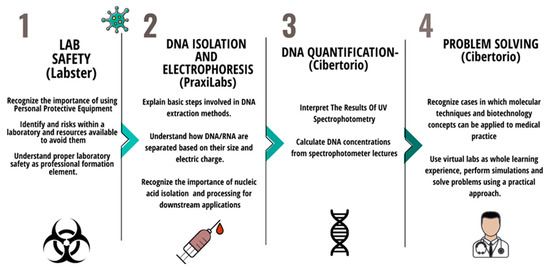
Figure 1.
Learning objectives pursued through the use of virtual platforms during the course.
2.3. Platforms
The platforms were selected based on the fact that they covered step-by-step lab safety instruction, the techniques of nucleic acid isolation, quantitative and qualitative assessment of DNA, and problem solving with medical examples using these techniques in accordance with the learning objectives of our program (Figure 1). By the time our course was implemented, these platforms were freely available. The VL platforms and practice activities were meticulously chosen to ensure that students not only grasped the fundamental principles of the techniques but also developed the ability to apply them when addressing future clinical challenges. For instance, students were taught the electrophoresis technique not just as a standalone procedure but also as a tool for solving human identification problems in a virtual environment. This approach facilitated the integration of their foundational knowledge into the resolution of real-world clinical issues.
2.3.1. Labster
Labster provides virtual laboratory simulations in the field of biosafety, among others. The simulations offer a realistic and immersive experience for understanding the fundamental principles of biosafety. These simulations are designed to promote safety and best practices in the laboratory by enabling students to learn through a highly interactive and engaging platform. As a result, the students develop a deeper understanding of safety protocols, ultimately preventing accidents in the laboratory. For instance, with these simulations, students can test different scenarios and make mistakes without any risk to themselves or others, allowing in this way to think what to do if a lab accident happens [13]. They learn when to use personal protective equipment, including safety glasses, gloves, and lab coats. This simulation was freely available, and a Spanish version of the instructions was available and worked properly in most electronic devices (https://www.labster.com/, accesed on 9 November 2020).
2.3.2. PraxiLabs
The PraxiLabs platform offers a range of laboratory simulations that cater to different fields of study from biology and chemistry to physics and engineering. The simulations provide students with a realistic and safe environment for experimenting without the need for expensive and often hazardous equipment. With the PraxiLabs platform, the students can practice their lab skills by carefully measuring and transferring liquids with virtual pipettes and prepare DNA separation matrices by virtually heating, pouring, and solidifying an agarose solution. These interactive exercises help reduce the gap between theoretical knowledge and practical application, allowing students to set their understanding of complex scientific concepts as they apply them in simulated lab scenarios [14]. We used it because it allows to perform a simulation to obtain DNA and prepare agarose gels for electrophoresis in a comprehensive manner. At the time of our practices, it was freely available (https://praxilabs.com/, accesed on 9 November 2020).
2.3.3. Cibertorio
Cibertorio (https://biomodel.uah.es/lab/cibertorio/, accesed on 26 January 2024) is a VL platform where students can carry out experiments and learn the necessary techniques and methods for biological sciences. Through the use of virtual tools, students can manipulate molecules and observe their behavior in an interactive and safe environment [15,16]. Unlike other platforms, in Cibertorio, students are able to select a problem, obtain a quote for which reagents to use, and perform exercises, all of which are included in the simulation. The techniques available at the time of our study were DNA fragmentation with restriction enzymes (RFLP polymorphism assays), PCR amplification, and gel electrophoretic separation of DNA fragments. This platform resulted in being particularly useful for integration of knowledge via problem-based learning (PBL) because students not only reviewed a molecular technique but also performed work planning and critical thinking. Therefore, this platform was selected for a final assignment in which students were expected to read, investigate, and perform the simulation of a specific problem, for instance, detection of SARS-CoV-2 using PCR, among other real life-based problems.
2.4. Questionnaire
In order to gain insights into students’ perceptions and attitudes towards biotechnology before and after the course, a 5-point Likert scale (5 = totally disagree, 4 = disagree, 3 = neutral, 2 = agree, 1 = totally agree) was used. The questionnaire used in this study was adapted and translated from a previously published study [17] to ensure its comprehensibility among medical students in Mexico. To ensure the reliability of the modified questionnaire, we conducted a test for internal consistency using Cronbach’s alpha that resulted in 0.88 (Spanish version of the questionnaire with 38 items) (Table 2), which exceeded the threshold of 0.7 for acceptability.

Table 2.
Students’ perceptions and attitudes towards biotechnology changes before and after the course.
To explore the general experience of students using virtual laboratory platforms used during the course, an online survey was answered by the students. The instruction was “Please rate your experience using virtual platforms”. Then, a 5-point Likert scale was used to rate platforms with sentences containing options (1 = poor; 2 = fair; 3 = good; 4 = very good; 5 = excellent). The assessment of student preferences and difficulties in performing practices in Cibertorio was conducted in the following manner: Preferences were determined by the number of teams that chose a particular practice as their top choice for presentation. Difficulty was evaluated by the number of errors made by teams during their presentations, which were categorized on a scale of 1 to 5; a rating of 1 indicated a low preference and low frequency of errors, while a rating of 5 indicated a high preference and frequency of errors.
2.5. Data Analysis
An exploratory analysis of the data was performed to determine normality. Data were not normally distributed. Thus, the non-parametric paired samples Wilcoxon test was used to compare paired data derived from pre- and post-questionnaires. SPSS Statistics 26.0 (Chicago, IL, USA) was used for data processing.
3. Results
3.1. Perceptions and Attitudes towards Biotechnology
Herein, we explored the perceptions and attitudes of third-year medical students towards biotechnology before and after the course, with emphasis on the experience using VL. In total, 210 third-year medical students completed the online questionnaire (79.3% response rate). About 47.6% of participants were female (n = 100) and 52.3% were male (n = 110). Although it was not expected to observe significant changes in perceptions and attitudes after only a three-week course, 7 out of 38 items showed significant changes, with p-values lower than 0.05 (Table 2).
Table 2 presents the questionnaire items, encompassing those that exhibited noteworthy alterations following the course. Subsequently, Figure 2, Figure 3, Figure 4 and Figure 5 delineate the manner in which the students’ perceptions and attitudes changed. The responses that did not show any change are available in the Supplementary Materials, as well as the complete version of the questionnaire in English and in Spanish.
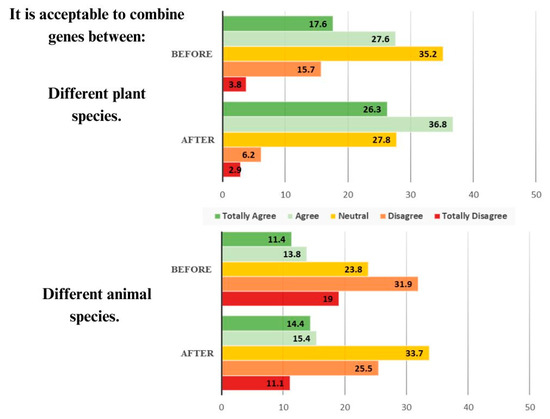
Figure 2.
Responses to genetic recombination statements before and after the course. Upper panel shows the significant change on perception regarding combining genes between different plant species (Wilcoxon test p = 0.001). Lower panel shows the significant change in perceptions regarding combining genes between different animal species (Wilcoxon test p = 0.02).
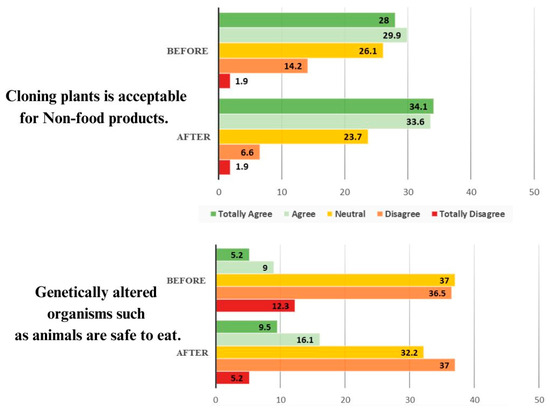
Figure 3.
Sentences related to cloning plants for non-food products and the safety of genetically altered animals for eating. Upper panel shows the significant change on perception regarding cloning plants for non-food products. (Wilcoxon test p = 0.01). Lower panel shows the significant change in perceptions regarding food safety in genetically altered animals (Wilcoxon test p = 0.04).
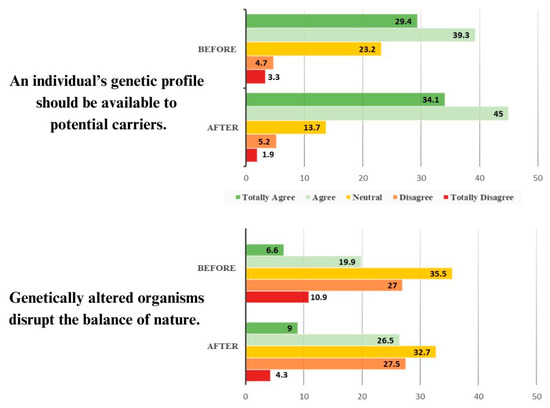
Figure 4.
Sentences related to legal issues and risks of biotechnology. Upper panel shows the significant change on perception regarding availability for genetic profiles for potential carriers. (Wilcoxon test p = 0.03). Lower panel shows the significant change in perceptions regarding the disruption of the balance of nature by genetically altered organisms (Wilcoxon test p = 0.02).
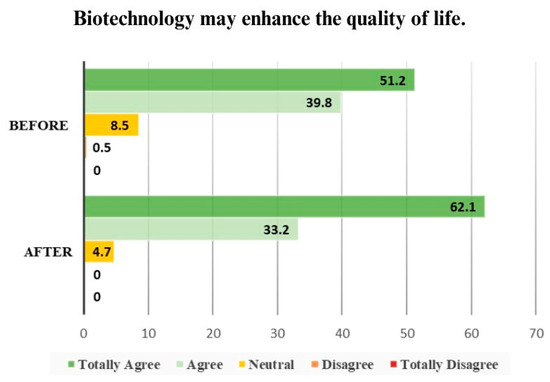
Figure 5.
Responses regarding benefits of biotechnology. The panel shows the significant change in perception regarding the capability of biotechnology to enhance the quality of life (Wilcoxon test p = 0.01).
Another objective of the present work was to gain insights into students’ experiences with the different virtual laboratory platforms. In this regard, all the platforms received satisfactory ratings, and no differences were found among them (p = 0.36). “Very good” and “Excellent” were the categories with the highest percentages and less than 2% was rated as poor in all platforms (Table 3).

Table 3.
Overall student experience with the different virtual laboratory platforms.
3.2. Students’ Preferences Regarding Problem-Based Learning and the Difficulty Level in Cibertorio
Another objective of the present work was to identify the preferences of our students regarding the practices offered in the Cibertorio platform and to recognize the degree of difficulty of such practices (Figure 6). Although in general all the platforms used during the course received good opinions from our students, potentials and pitfalls among platforms still exist. Among the selected practices in Cibertorio, most students had “SARS-CoV-2 detection by PCR assay” as first choice, followed by analysis of contaminated food and forensic analysis using RFLP. Nevertheless, in our experience, the number of errors performed by the students in each case showed that the most difficult exercise in that platform was molecular diagnosis of beta S globin using RFLP and SARS-CoV-2 detection by PCR assay (Table 2). Most errors arose from data interpretation, like the need for constitutive gene controls required in some PCR reactions. A guide to solve each case is available, indicating which virtual tool and reagents should be used (Figure 7).
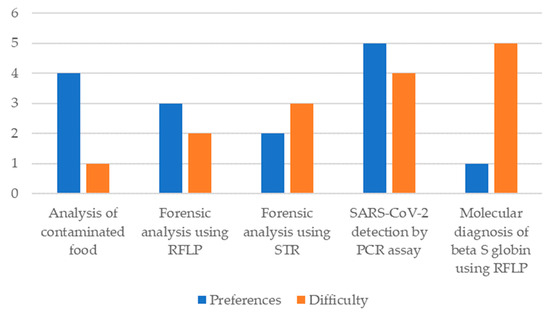
Figure 6.
Students’ preferences and the difficulty levels of practices in Cibertorio. The graph shows the teams’ preferences (in blue) for presenting the practices at the exhibition, defined as the number of teams that selected the practice as their first choice. The difficulty (in orange) is expressed as the number of errors made by the teams that presented the practice, categorized from 1 to 5, with 1 being the lowest preference and frequency of errors, and 5 being the highest preference and frequency of errors.
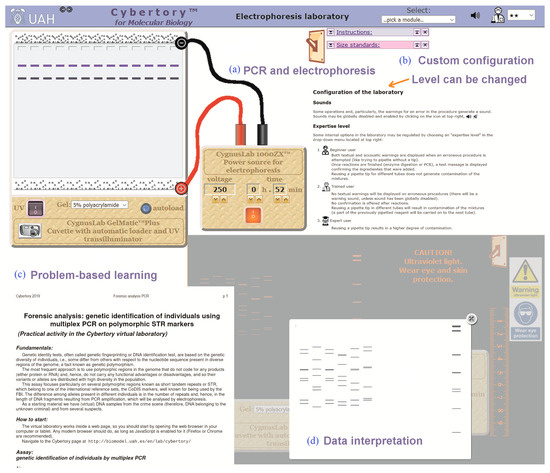
Figure 7.
Example of problem-based learning about human identification by PCR and electrophoresis in Cibertorio. Upper panel shows the following: (a) the graphical display of electrophoresis showing volts, positive and negative positions in the gel, and charged samples (blue); (b) configuration of users can be modified according to expertise (two stars means intermediate level); (c) instructions and human identification problems to be solved in Cibertorio; and (d) data interpretation showing differences in the length of fragments of individuals after PCR and electrophoresis.
4. Discussion
In this study, we aimed to investigate medical students’ perceptions and attitudes towards biotechnology before and after completing a course involving VL. We also wanted to know the students’ experiences with the platforms and practices used. The primary objective of this study was to ascertain whether this online course could successfully change student perceptions and attitudes, thereby enhancing the overall learning experience. The conventional laboratory practices (wet-lab) we planned for students before the pandemic would be conducted in person with certain limitations. However, the pandemic and lockdown forced us to move to a fully online approach. This experience showed that the shift to online delivery has proven to be beneficial, allowing for the implementation of practices that would have been challenging or impossible in a conventional face-to-face setting, even without the restrictions imposed by the pandemic. For example, DNA quantification, which necessitates the use of spectrophotometry equipment such as Nanodrops, was effectively carried out using the Cibertorio virtual platform. This overcame the constraints of our teaching laboratories. Likewise, PCR reactions and the subsequent interpretation of results were successfully performed virtually. The in-person execution of these two-hour practices would have been impractical due to the extensive preparation, running time, and data analysis required. Furthermore, the cost of reagent consumables and infrastructure would have presented significant limitations for in-person implementation. The use of virtual platforms for remote learning not only facilitated the execution of these practices but also enhanced the overall learning experience. Various studies, including those by AbuQamar [18] et al., Orhan et al. [1], and Ching-pong Poo et al. [5] have emphasized the need for improved biotechnology education to enhance public understanding and acceptance of this technology. Our study aligns with these findings, demonstrating that the incorporation of VL can effectively enhance student perceptions of biotechnology, potentially surpassing the impact of traditional in-person laboratory experiences.
A didactic principle involved in the use of VL to teach biotechnology to students is, for example, active learning, since VL allow students to learn while being the center of their own educational experience, since they are the ones who carry out the experiments, ask questions, and make observations. This allows them to acquire knowledge and skills in a significant way. Additionally, according to the principle of adaptation to individual needs, VL can offer personalized learning [19] by adapting to the individual needs of students as they can modify different levels of difficulty and support resources, particularly in the case of the Cibertorio platform. These principles are based on constructivist theories of learning, which sustain that students learn by creating their own knowledge from their experiences [20,21]. VL offers students the opportunity to experiment with biotechnology in a safe and realistic way, allowing them to develop a deep understanding of this discipline. VL can also be used to promote the development of critical thinking skills because VL requires students to analyze the data rigorously to draw conclusions from experiments. This helps them improve skills such as problem solving, decision making, and scientific reasoning. This allows all students to develop their capabilities favoring the changing roles in education, where the professor is a guide and the students become protagonists of their own knowledge. Hence, VL platforms enable teachers to remotely supervise students conducting experiments that, when performed in person, represent potential risks due to inexperience with handling substances and equipment. This minimizes the physical strain on teachers and optimizes resource utilization by balancing the educational triangle (institution, teacher, student), ultimately enhancing student learning without increasing costs or teacher fatigue.
It is worth noting that virtual laboratories are a valuable tool in biotechnology education; however, they do have limitations. One major drawback is the lack of dexterity and psychomotor skills that are essential for hands-on experimentation and technique execution. Consequently, students may not acquire vital laboratory skills like pipetting and equipment manipulation. Moreover, the extensive screen time required by these platforms can lead to student disengagement. Additionally, the predominantly individualistic nature of virtual laboratories can hinder the development of collaborative skills and peer learning, both of which are crucial for scientific education. Furthermore, these platforms may be inaccessible to some students due to software prerequisites. Notably, two out of the three platforms used in this study are owned by private entities. Although these platforms were freely accessible during the course, the companies may impose usage fees in the future, potentially eliminating the permanent free-access feature. Technological obsolescence is another concern, as it can impact student motivation and reduce interactivity, thereby reducing the effectiveness of virtual reality labs as educational tools [6]. To mitigate this, regular updates and potential redesigns are necessary. However, commercial platforms like Labster and PraxiLabs are expected to adapt to compatibility changes. On the other hand, Cibertorio, being a non-commercial open platform under the Creative Commons license and using browser-supported formats like HTML5, JavaScript, and CSS, is less likely to face obsolescence. Moreover, it offers opportunities for future updates by interested parties.
Therefore, a separate study is needed to evaluate the effectiveness of virtual laboratories in facilitating knowledge acquisition.
Perceptions are the meanings, images, and beliefs that people have [22]. The media can influence these perceptions positively by focusing on the potential benefits or negatively by focusing on the risks involved. For example, media coverage of biotechnology has focused on the multiple benefits of new medications and treatments against cancer or the reduction of hunger by optimizing the properties of plants of agro-alimentary interest [23]. However, media coverage has also highlighted the potential risks of genetic engineering, such as the reduction or elimination of native species or the risk that genetic testing will affect access to health coverage by insurance companies or lead to acts of discrimination due to physical disabilities or physiological defects. These distorted representations of biotechnology can lead students to develop negative attitudes towards biotechnology. In addition, factors such as personal beliefs, religious values, and cultural norms may modify students’ emotional responses, which can be positive, negative, or neutral and can greatly impact their motivation and engagement for learning.
As indicated by the changes in perceptions after the course, it is clear that exposure to information and education using VL increases the acceptance and understanding of biotechnology. For instance, one of the practices considered a favorite by most students due to its simplicity was to detect food contamination with DNA from different animal species (Figure 6). Understanding how to detect genetically modified organisms (GMOs) can help improve public perception of their use in food products, especially when they are clearly labeled before being sold. Educational experiences that teach students how to detect foreign DNA in food can foster informed opinions about the labeling and consumption of GMOs. Interestingly, despite concerns about GMOs, our research suggests that clear information and regulations can influence acceptance among students. This is concordant with the results found by Rathod and collaborators, where a positive attitude towards GMOs and foods was observed in relation to knowledge about them [24]. On the other hand, a study at Riyadh University found almost no willingness to purchase or try GMO products. Moreover, that study revealed that the students considered GM foods harmful and could not be easily detected [25]. Interestingly, our data showed that the acceptance of genetic manipulation varied according to the purpose and type of organism involved. For example, although it was generally acceptable to combine genes within the same species, the idea of inserting foreign genes or cloning animals for human consumption was perceived as not acceptable, while doing so in plants received a more positive view. This is concordant with previous findings in a study of high school students in which most participants demonstrated positive attitudes towards different applications of biotechnology, except when animal manipulation was involved [26]. On the other hand, the regulation or blockade of genes within the organism received better perception than gene transfer. Our data suggest that the level of acceptance varied according to the perceived benefits and risks of biotechnology. Most of the students perceived the uses of biotechnology as justifiable or positive when it came to medical purposes or when used to prevent diseases in potential carriers.
With regard to the field of clinical applications of biotechnology, a recent study found that many American doctors do not feel adequately prepared to apply medical genetics and genomics in a clinical setting [27]. This self-perception of lack of preparedness may be attributed to inadequate training during their education and limited access to genetic expertise. Also, a recent study showed that 72.6% of the students would be able to identify patients in their future practice who could benefit from genetic testing. It may be advised that better education could lead to more confident physicians in genetic testing practices [28]. Therefore, it is worth highlighting that some of the practices in Cibertorio involve the detection of carriers of genetic diseases and the determination of genetic profiles through laboratory techniques carried out in virtual environments, for which we hypothesize that this experience provides a realistic and integral perspective to the students so that they have an objective view of the applications of biotechnology in medicine that makes them feel more confident in their future medical practice. While the increase in students’ perception of biotechnology as a job-creating field did not reach statistical significance, it still warrants attention as it aligned with the aforementioned concerns regarding the impact of biotechnology on employment opportunities.
While additional research is needed, our data suggest that students have concerns about the potential misuse of biotechnology, particularly regarding genetic information discrimination. Despite Mexican regulations protecting the confidentiality of genetic information, students may feel their rights are not adequately protected. The recent introduction of this course into their medical program may contribute to students’ hesitation. Thus, issues such as anxiety, depression, and stigmatization associated with genetic testing need to be addressed in the classroom.
Students’ concerns also extend to biotechnological animal experimentation, particularly the unpredictable outcomes of genome modification. Conducting our study at a catholic university with conservative values highlights the ethical considerations of significantly altering organisms and disrupting nature’s balance.
These findings emphasize the importance of addressing these topics in class to alleviate students’ concerns and clarify their doubts about the ethical and legal aspects of using genetic information and the consequences of animal experimentation in biotechnology.
It is important to mention that our study focused specifically on students’ perceptions and attitudes towards biotechnology, so academic performance was not measured. Despite this, various studies have shown that the use of VL can have a positive impact on both perceptions [29] and the knowledge acquired by students. Controversially, other studies have found no effect of VL on students’ knowledge [30,31]. For example, in the study by Ibrahim et al. [32], two virtual biochemistry practices were used for university students. The results were contrasting when evaluating performance and knowledge assimilation; one of the tools showed a positive result, while the other showed low performance. This corresponds with our findings regarding student performance in problem-solving in Cibertorio. One of the students’ preferred practices, the detection of COVID-19 by PCR, was also one of those that presented the most errors by the students. Therefore, it is crucial to highlight that the selection of practices in VL must be careful and in line with learning objectives.
We propose that biotechnology applied to medicine could combine in-person and virtual laboratory practices. This innovative teaching method aims not only to improve knowledge but also to enhance the perceptions and attitudes of future physicians, ultimately benefiting both their professional growth and the society they serve. While further research is needed to quantify the impact of VL on knowledge acquisition in such a short course, our study reveals the potential of VL to rapidly reshape student perspectives and attitudes. This shift, fostered by a more positive perception of biotechnology’s medical applications, can be vital in sparking interest and engagement with this crucial subject. Our findings offer valuable insights for institutions seeking to correct student misconceptions and negative attitudes, particularly in contexts lacking information or that are riddled with misinformation about the medical potential of biotechnology.
5. Conclusions
In conclusion, our study demonstrates that virtual laboratories can effectively change the attitudes and perceptions of medical students towards biotechnology in a short span of time. Our study also reveals the topics that captivated the students’ interest during the practices, as well as the frequent errors they committed while performing or interpreting them. Virtual laboratories can enhance the learning experience by complementing face-to-face practices and improving the teaching–learning process. Moreover, our study uncovers some issues that students had regarding the use of genetic information and animal experimentation in biotechnology applied to medicine, which should be discussed during the classes. Nevertheless, further research that include open-ended questions and other biotechnology questions regarding genome editing, tissue engineering, and nanotechnology can expand our perspective of the scope of virtual laboratories on various variables of educational interest for doctors in training.
Supplementary Materials
The following supporting information can be downloaded at: https://www.mdpi.com/article/10.3390/educsci14020157/s1. Video S1: A video-abstract is available Biotech Education Virtual Laboratories (1).mp4.
Author Contributions
Conceptualization, E.O.Z.-G., A.H. and L.B.L.-H.; data curation, P.D.G.-M., O.T.-B., C.A.C.-R. and B.G.-D.; formal analysis, E.O.Z.-G. and L.B.L.-H.; investigation and project administration, N.A.V.-C.; resources, L.B.L.-H. and N.A.V.-C.; supervision, E.O.Z.-G. and L.B.L.-H.; visualization, A.M.-C., N.L.-P. and M.V.T.-M.; writing—original draft, E.O.Z.-G. and L.B.L.-H.; Writing—review and editing, M.V.T.-M., M.M.J.R.-B., E.O.Z.-G. and L.B.L.-H. All authors have read and agreed to the published version of the manuscript.
Funding
This research received no external funding.
Institutional Review Board Statement
This study was registered and approved by our Institutional Research Coordination. Participation was voluntary and anonymous. The approval number assigned to this project by the Review Board was 2021-B-01.
Informed Consent Statement
Consent for participation was obtained in the questionnaire format previous to answering the questionnaire, which was anonymous and voluntarily taken by participants, therefore conventional written informed consent was waived.
Data Availability Statement
Database available upon request.
Acknowledgments
We thank all participants that made this work possible.
Conflicts of Interest
The authors declare no conflicts of interest. AH is the creator of Cibertorio; nonetheless, all platforms were evaluated equally.
References
- Orhan, T.Y.; Sahin, N. The Impact of Innovative Teaching Approaches on Biotechnology Knowledge and Laboratory Experiences of Science Teachers. Educ. Sci. 2018, 8, 213. [Google Scholar] [CrossRef]
- Woźniak-Gientka, E.; Tyczewska, A.; Twardowski, T. Public opinion on biotechnology and genetic engineering in the European Union: Polish consumer study. BioTechnologia 2022, 103, 185–201. [Google Scholar] [CrossRef] [PubMed]
- INEGI. Percepción Sobre Ciencia y Tecnología. Available online: https://www.inegi.org.mx/temas/pecyt/#informacion_general (accessed on 27 January 2024).
- Casanoves de la Hoz, M.; Solé-Llussà, A.; Haro, J.; Gericke, N.; Valls, C. Student Primary Teachers’ Knowledge and Attitudes Towards Biotechnology—Are They Prepared to Teach Biotechnological Literacy? J. Sci. Educ. Technol. 2022, 31, 203–216. [Google Scholar] [CrossRef]
- Poo, M.C.-P.; Lau, Y.-Y.; Chen, Q. Are Virtual Laboratories and Remote Laboratories Enhancing the Quality of Sustainability Education? Educ. Sci. 2023, 13, 1110. [Google Scholar] [CrossRef]
- Vergara, D.; Extremera, J.; Pablo Rubio, M.; Dávila, L.P. The Technological Obsolescence of Virtual Reality Learning Environments. Appl. Sci. 2020, 10, 915. [Google Scholar] [CrossRef]
- Dyrberg, N.R.; Treusch, A.H.; Wiegand, C. Virtual laboratories in science education: Students’ motivation and experiences in two tertiary biology courses. J. Biol. Educ. 2017, 51, 358–374. [Google Scholar] [CrossRef]
- Alsoufi, A.; Alsuyihili, A.; Msherghi, A.; Elhadi, A.; Atiyah, H.; Ashini, A.; Ashwieb, A.; Ghula, M.; Ben Hasan, H.; Abudabuos, S.; et al. Impact of the COVID-19 pandemic on medical education: Medical students’ knowledge, attitudes, and practices regarding electronic learning. PLoS ONE 2020, 15, e0242905. [Google Scholar] [CrossRef] [PubMed]
- Sherrer, S.M. A virtual laboratory module exploring photosynthesis during COVID-19. Biochem. Mol. Biol. Educ. 2020, 48, 659–661. [Google Scholar] [CrossRef]
- Alvarez, K.S. Using Virtual Simulations in Online Laboratory Instruction and Active Learning Exercises as a Response to Instructional Challenges during COVID-19. J. Microbiol. Biol. Educ. 2021, 22, 2503. [Google Scholar] [CrossRef]
- de Vries, L.E.; May, M. Virtual laboratory simulation in the education of laboratory technicians-motivation and study intensity. Biochem. Mol. Biol. Educ. 2019, 47, 257–262. [Google Scholar] [CrossRef]
- Bátor, J.; Szeberényi, J. Problem solving in the time of coronavirus pandemic. Biochem. Mol. Biol. Educ. 2021, 49, 882–887. [Google Scholar] [CrossRef]
- Tripepi, M. Microbiology Laboratory Simulations: From a Last-Minute Resource during the Covid-19 Pandemic to a Valuable Learning Tool to Retain—A Semester Microbiology Laboratory Curriculum That Uses Labster as Prelaboratory Activity. J. Microbiol. Biol. Educ. 2022, 23, e00269-21. [Google Scholar] [CrossRef]
- Ibrahem, U.M.; Alsaif, B.S.; Alblaihed, M.; Ahmed, S.S.I.; Alshrif, H.A.; Abdulkader, R.A.; Diab, H.M. Interaction between cognitive styles and genders when using virtual laboratories and its influence on students of health college’s laboratory skills and cognitive load during the Corona pandemic. Heliyon 2022, 8, e09213. [Google Scholar] [CrossRef]
- Herráez, A. Virtual laboratories as a tool to support learning. Turk. J. Biochem. 2020, 47, 195–200. [Google Scholar] [CrossRef]
- Díez, J.C.; Herráez, Á. Iniciación al diagnóstico genético: Una aproximación a la medicina molecular. Rev. Investig. Educ. Cienc. Salud (RIECS) 2017, 2, 22–27. [Google Scholar] [CrossRef]
- Sohan, D.E.; Waliczek, T.M.; Briers, G.E. Knowledge, Attitudes, and Perceptions Regarding Biotechnology among College Students. J. Nat. Resour. Life Sci. Educ. 2002, 31, 5–11. [Google Scholar] [CrossRef]
- AbuQamar, S.; Alshannag, Q.; Sartawi, A.; Iratni, R. Educational awareness of biotechnology issues among undergraduate students at the United Arab Emirates University. Biochem. Mol. Biol. Educ. 2015, 43, 283–293. [Google Scholar] [CrossRef] [PubMed]
- Dumulescu, D.; Pop-Păcurar, I.; Necula, C.V. Learning Design for Future Higher Education—Insights from the Time of COVID-19. Front. Psychol. 2021, 12, 647948. [Google Scholar] [CrossRef] [PubMed]
- Dong, H.; Lio, J.; Sherer, R.; Jiang, I. Some Learning Theories for Medical Educators. Med. Sci. Educ. 2021, 31, 1157–1172. [Google Scholar] [CrossRef] [PubMed]
- Kok, Y.Y.; Er, H.M.; Nadarajah, V.D. An Analysis of Health Science Students’ Preparedness and Perception of Interactive Virtual Laboratory Simulation. Med. Sci. Educ. 2021, 31, 1919–1929. [Google Scholar] [CrossRef] [PubMed]
- Glerum, A.; Atasoy, B.; Bierlaire, M. Using semi-open questions to integrate perceptions in choice models. J. Choice Model. 2014, 10, 11–33. [Google Scholar] [CrossRef]
- Ho, S.; Scheufele, D.; Corley, E. Factors influencing public risk—Benefit considerations of nanotechnology: Assessing the effects of mass media, interpersonal communication, and elaborative processing. Public Underst. Sci. 2013, 22, 606–623. [Google Scholar] [CrossRef] [PubMed]
- Rathod, D.; Hedaoo, R.P. Assessment of Knowledge and Attitudes on Genetically Modified Foods among Students Studying Life Sciences. Cureus 2022, 14, e32744. [Google Scholar] [CrossRef]
- Al-Jebreen, D.H. Perceptions and attitudes of Riyadh university students towards products derived from genetically modified crops in Saudi Arabia. Pak. J. Biol. Sci. 2010, 13, 28–33. [Google Scholar] [CrossRef][Green Version]
- Fonseca, M.J.; Costa, P.; Lencastre, L.; Tavares, F. Multidimensional analysis of high-school students’ perceptions about biotechnology. J. Biol. Educ. 2012, 46, 129–139. [Google Scholar] [CrossRef]
- French, E.L.; Kader, L.; Young, E.E.; Fontes, J.D. Physician Perception of the Importance of Medical Genetics and Genomics in Medical Education and Clinical Practice. Med. Educ. Online 2023, 28, 2143920. [Google Scholar] [CrossRef]
- Bukic, J.; Rusic, D.; Leskur, D.; Perisin, A.S.; Cohadzic, T.; Kumric, M.; Bozic, J.; Modun, D. Investigation of Biomedical Students’ Attitudes toward Pharmacogenomics and Personalized Medicine: A Cross-Sectional Study. Pharmacy 2022, 10, 73. [Google Scholar] [CrossRef] [PubMed]
- Kay, R.; Goulding, H.; Li, J. Assessing the Impact of a Virtual Lab in an Allied Health Program. J. Allied Health 2018, 47, 45–50. [Google Scholar]
- Doruk, O.; Sarıkaya, R. An Examination of the Studies between 2013–2022 on the Use of Virtual Laboratories in Science Education. Gazi Üniv. Gazi Eğitim Fakültesi Derg. 2023, 43, 1451–1485. [Google Scholar] [CrossRef]
- Celine, B.; Nsanganwimana, F.; Tarmo, A. Investigating the effect of virtual laboratories on students’ academic performance and attitudes towards learning biology. Educ. Inf. Technol. 2023, 29, 1147–1171. [Google Scholar] [CrossRef]
- Ibrahim, G.; Morcos, G.; Ghaly, W.; Hassan, M.; Hussein, U.; Nadim, H. Perception of competence achievement and students’ satisfaction using virtual laboratories in Medical Biochemistry course: Lessons from the COVID-19 pandemic. Biochem. Mol. Biol. Educ. 2023, 51, 254–262. [Google Scholar] [CrossRef] [PubMed]
Disclaimer/Publisher’s Note: The statements, opinions and data contained in all publications are solely those of the individual author(s) and contributor(s) and not of MDPI and/or the editor(s). MDPI and/or the editor(s) disclaim responsibility for any injury to people or property resulting from any ideas, methods, instructions or products referred to in the content. |
© 2024 by the authors. Licensee MDPI, Basel, Switzerland. This article is an open access article distributed under the terms and conditions of the Creative Commons Attribution (CC BY) license (https://creativecommons.org/licenses/by/4.0/).